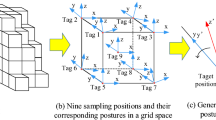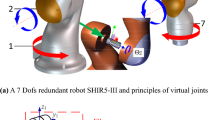Abstract
In real industrial environment, the stiffness identification accuracy of manipulators is affected by various measurement errors. However, research that deals with the inevitable error perturbation is scarce. The κF(A)−1 criterion is adopted for measurement configuration selection to solve this problem according to the perturbation analysis and derivation of solutions to systems of stiffness identification equations. The optimal measurement configurations are finally obtained using the DETMAX optimization algorithm based on the deduced criterion, which is the main contribution of this work. Results illustrate that the optimal configurations optimized by the DETMAX algorithm based on the κF(A)−1 criterion can better overcome the influence of measurement errors, improve the identification accuracy, and reduce the compensated position error and fluctuation compared with the other optimization algorithms. Furthermore, the proposed criterion can be applied to the stiffness identification of serial manipulators in a real industrial environment.
Similar content being viewed by others
Abbreviations
- ΩJ :
-
N alternative configuration sets selected by means of κF(J)−1
- ΩF :
-
N alternative external force sets
- ζi :
-
ith measurement configuration
- γ M = [ζ 1,ζ 2,⋯, ζ i,⋯ζ M]:
-
M selected measurement configurations
- Ω = [ζ 1,ζ 2,⋯, ζ i,⋯ζ N]:
-
N alternative configuration sets in the whole workspace
- ΩR = Ω−γ M :
-
U residual unselected configurations (U = N−M)
- κ F(γ M)−1 :
-
Enhanced evaluation index of selected configurations
- ζ + :
-
Configuration chosen inside ΩR (ζ+ ∈ ζR) to be added to γM+1=γM+ζ+, to maximize the current κF(γM+1)−1
- ζ− :
-
Configuration chosen inside γM+1 to be eliminated to maximize the current κF(γM)−1, γM=γM+1−ζ
References
C. Dumas, S. Caro, S. Garnier and B. Furet, Joint stiffness identification of six-revolute industrial serial robots, Robot Comput. Integr. Manuf., 27 (2011) 881–888.
C. Dumas, S. Caro, M. Cherif, S. Garnier and B. Furet, Joint stiffness identification of industrial serial robots, Robotica, 30(4) (2012) 649–659.
H. Zhang, J. Wang, G. Zhang and Z. Gan, Machining with flexible manipulator: toward improving robotic machining performance, Proc. of the 2005 IEEE International Conference on Advanced Intelligent Mechatronics, Monterey, USA (2005) 1127–1132.
E. Abele, M. Weigold and S. Rothenbücher, Modeling and identification of an industrial robot for machining applications, Annals of the CIRP, 56(1) (2007) 387–390.
M. Spong, Modeling and control of elastic joint robots, J. Dyn. Sys. Meas., Control, 109 (1987) 310–319.
S. F. Chen and I. Kao, Conservative congruence transformation for joint and Cartesian stiffness matrices of robotic hands and fingers, Int. J. Robot. Res., 19 (2000) 835–847.
S. F. Chen, The 6×6 stiffness formulation and transformation of serial manipulators via the CCT theory, Proc. of the 2003 IEEE International Conference on Robotics and Automation, Taipei (2003) 4042–4047.
G. Alici and B. Shirinzadeh, Enhanced stiffness modeling, identification and characterization for robot manipulators, IEEE Trans. Rob., 21(4) (2005) 554–564.
A. Klimchik, B. Furet, S. Caro and A. Pashkevich, Identification of the manipulator stiffness model parameters in industrial environment, Mech. Mach. Theory, 90 (2015) 1–22.
A. Nubiola and I. A. Bonev, Absolute calibration of an ABB IRB 1600 robot using a laser tracker, Robot. Comput. Intergr. Manuf., 29 (2013) 236–245.
A. Klimchik, Y. Wu, C. Dumas and S. Caro, Identification of geometrical and elastostatic parameters of heavy industrial robots, 2013 IEEE International Conference on Robotics and Automation, Karlsruhe, Germany (2013) 3707–3714.
J. H. Jang, S. H. Kim and Y. K. Kwak, Calibration of geometric and non-geometric errors of an industrial robot, Robotica, 19(3) (2001) 311–321.
J. Zhou, H. N. Nguyen and H. J. Kang, Simultaneous identification of joint compliance and kinematic parameters of industrial robots, Int. J. Precis. Eng. Man., 15(11) (2014) 2257–2264.
M. Cordes and W. Hintze, Offline simulation of path deviation due to joint compliance and hysteresis for robot machining, Int. J. Adv. Manuf. Technol., 90 (2017) 1075–1083.
K. Yang, W. Yang and C. Wang, Inverse dynamic analysis and position error evaluation of the heavy-duty industrial robot with elastic joints: an efficient approach based on Lie group, Nonlinear Dyn., 93 (2018) 487–504.
Z. Fu, J. S. Dai, K. Yang and X. Chen, Analysis of unified error model and simulated parameters calibration for robotic machining based on Lie theory, Robot. Comput. Intergr. Manuf., 61 (2020) 101855.
M. F. Zaeh and O. Roesch, Improvement of the machining accuracy of milling robots, Prod. Eng. Res. Devel., 8(6) (2014) 737–744.
J. K. Salisbury, Active stiffness control of a manipulator in Cartesian coordinates, 19th IEEE Conference on Decision and Control, Albuquerque, USA (1980) 95–100.
Y. Guo, H. Dong and Y. Ke, Stiffness-oriented posture optimization in robotic machining applications, Robot. Comput. Intergr. Manuf., 35 (2015) 69–76.
G. Xiong, Y. Ding and L. Zhu, Stiffness-based pose optimization of an industrial robot for five-axis milling, Robot. Comput. Intergr. Manuf., 55 (2019) 19–28.
Y. Bu, W. Liao, W. Tian, J. Zhang and L. Zhang, Stiffness analysis and optimization in robotic drilling application, Precision Engineering, 49 (2017) 388–400.
T. Cvitanic, V. Nguyen and S. N. Melkote, Pose optimization in robotic machining using static and dynamic stiffness models, Robot Comput. Integr. Manuf., 66 (2020) 101992.
Y. Tian, B. Wang, J. Liu, H. Shen, F. Xi and L. Li, Stiffness modeling and analysis of a multiple coordinated robot system, Int. J. Adv. Manuf. Technol., 94 (2018) 4265–4276.
A. Klimchik, E. Magid and A. Pashkevich, Design of experiments for elastostatic calibration of heavy industrial robots with kinematic parallelogram and gravity compensator, 2016 International Federation of Automatic Control, 49(12) (2016) 967–972.
A. Klimchik, Y. Wu, A. Pashkevich, S. Caro and B. Furet, Optimal selection of measurement configurations for stiffness model calibration of anthropomorphic manipulators, Appl. Mech. Mater., 162 (2012) 161–170.
W. Wang, H. Song, Z. Yan, L. Sun and Z. Du, A universal index and an improved PSO algorithm for optimal pose selection in kinematic calibration of a novel surgical robot, Robot. Comput. Intergr. Manuf., 50 (2018) 90–101.
G. Nawratil, New performance indices for 6R robots, Mech. Mach. Theory, 42 (2007) 1499–1511.
W. A. Khan and J. Angeles, The kinetostatic optimization of robotic manipulators: the inverse and the direct problems, J. Mech. Design, 128 (2006) 168–178.
G. Carbone and M. Ceccarelli, Comparison of indices for stiffness performance evaluation, Front. Mech. Eng. China, 5(3) (2010) 270–278.
Y. Wu, A. Klimchik, A. Pashkevich, S. Caro and B. Furet, Optimality criteria for measurement poses selection in calibration of robot stiffness parameters, Proc. of the ASME 2012 11th Biennial Conference on Engineering Systems Design and Analysis, Nantes, France (2012) 185–194.
C. Dumas, S. Caro, M. Chérif, S. Garnier and B. Furet, A methodology for joint stiffness identification of serial robots, The 2010 IEEE/RSJ International Conference on Intelligent Robots and Systems, Taipei (2010) 464–469.
M. Hu, H. Wang and X. Pan, Optimal configuration selection for stiffness identification of 7-Dof collaborative robots, Intel. Serv. Robot., 13 (2020) 379–391.
G. Chen, T. Li, M. Chu, J. Xuan and S. Xu, Review on kinematics calibration technology of serial robots, Int. J. Precis. Eng. Man., 15(8) (2014) 1759–1774.
A. Klimchik, Y. Wu, S. Caro, B. Furet and A. Pashkevich, Geometric and elastostatic calibration of robotic manipulator using partial pose measurements, Adv. Robotics, 28(21) (2014) 1419–1429.
A. Klimchik, A. Pashkevich and D. Chablat, Fundamentals of manipulator stiffness modeling using matrix structural analysis, Mech. Mach. Theory, 133 (2019) 365–394.
M. T. Mason and J. K. Salisbury, Robot Hands and the Mechanics of Manipulation, MIT Press, Cambridge, MA (1985).
J. Li and X. Zhang, Matrix Analysis and Computation, Wuhan University Press, Wuhan (2013).
D. Daney, Y. Pagegay and B. Madeline, Choosing measurement poses for robot calibration with the local convergence method and Tabu search, Int. J. Robot. Res., 24 (2005) 501–518.
J. Zhou, H. N. Nguyen and H. J. Kang, Selecting optimal measurement poses for kinematic calibration of industrial robots, Adv. Mech. Eng., 2014 (2014) 291389.
Acknowledgments
This work is supported by Research Program supported by the National Natural Science Foundation of China (No. 51575092) and the Central Leading Local Science and Technology Development Foundation of Liaoning Province (No. 2021JH6/10500132).
Author information
Authors and Affiliations
Corresponding author
Additional information
Xuejie Jiang is currently a Ph.D. student of the School of Mechanical Engineering and Automation, Northeastern University, Shenyang, China. Her current research interests include robot kinematic calibration, stiffness identification, and trajectory planning.
Lijin Fang (corresponding author) is currently a Professor and a Ph.D. candidate supervisor of the Faculty of Robot Science and Engineering, Northeastern University, Shenyang, China. His current research interests include robot accuracy control and humanoid control of variable stiffness robot.
Rights and permissions
About this article
Cite this article
Jiang, X., Fang, L. Optimal configuration selection method for stiffness identification of serial manipulators based on the κf(A)−1 criterion. J Mech Sci Technol 36, 2559–2570 (2022). https://doi.org/10.1007/s12206-022-0437-7
Received:
Revised:
Accepted:
Published:
Issue Date:
DOI: https://doi.org/10.1007/s12206-022-0437-7




